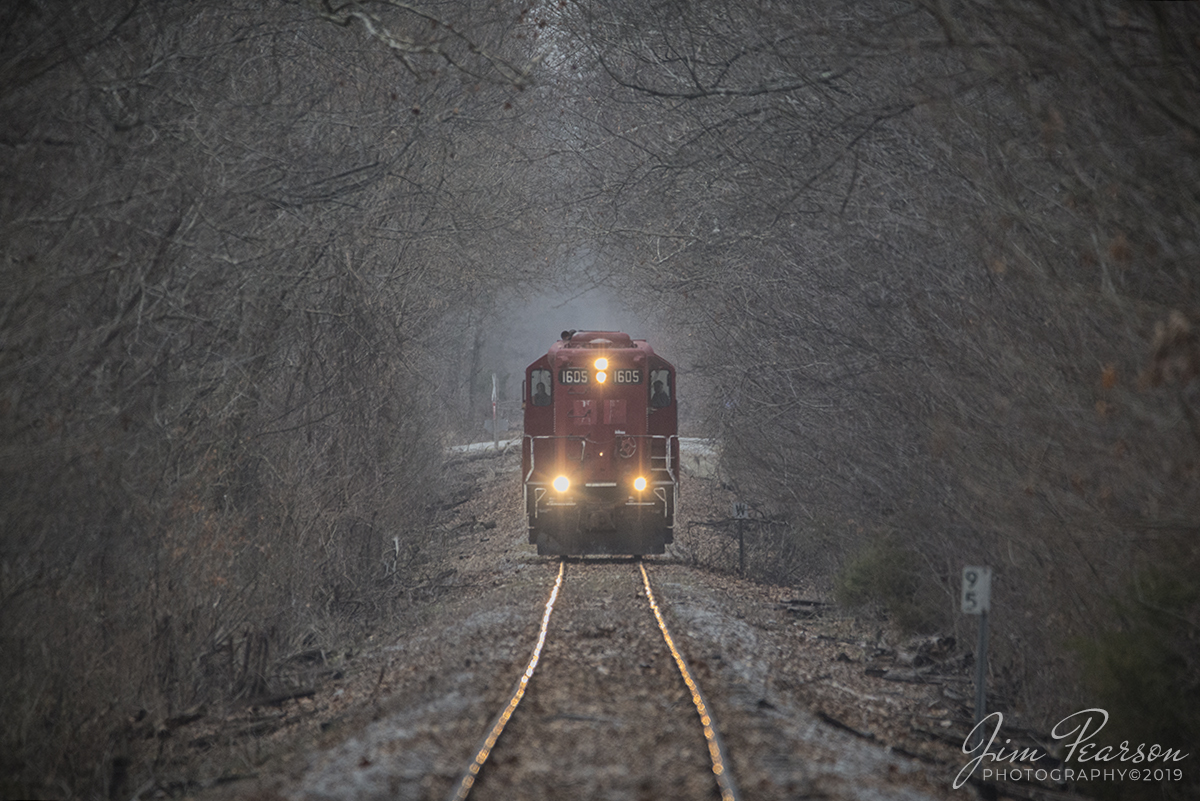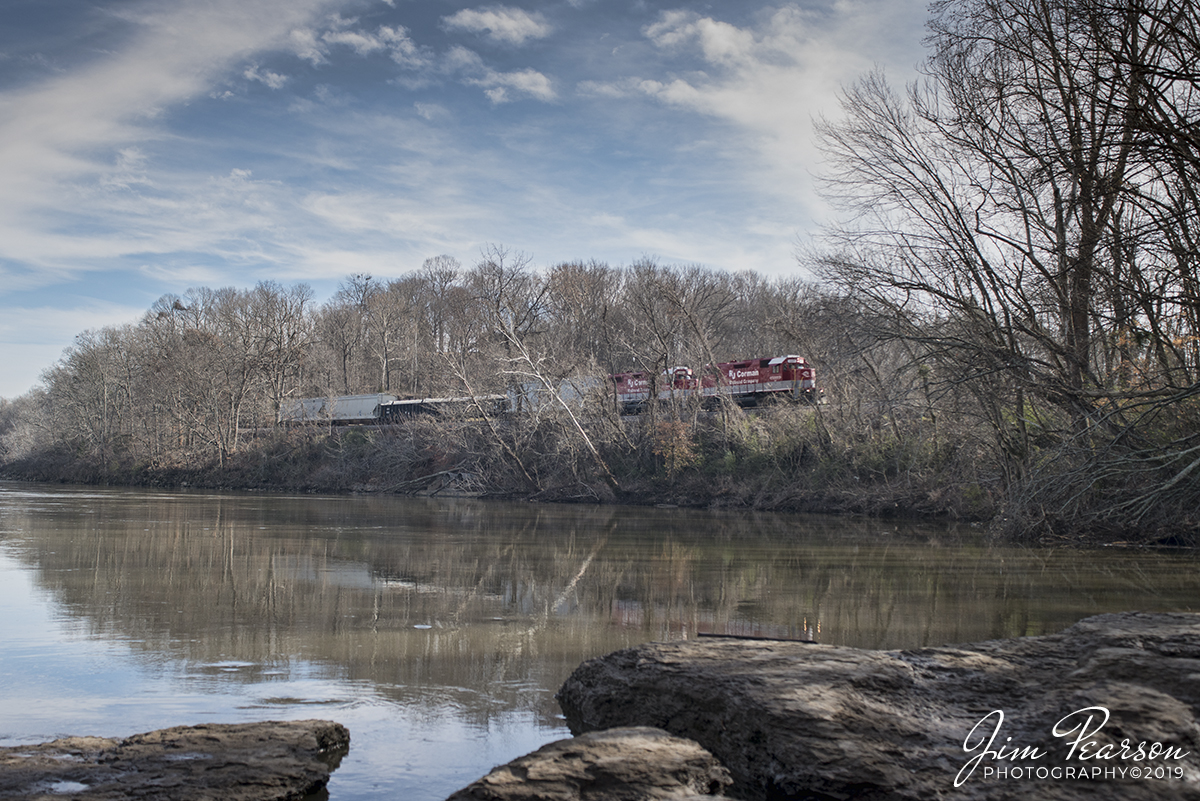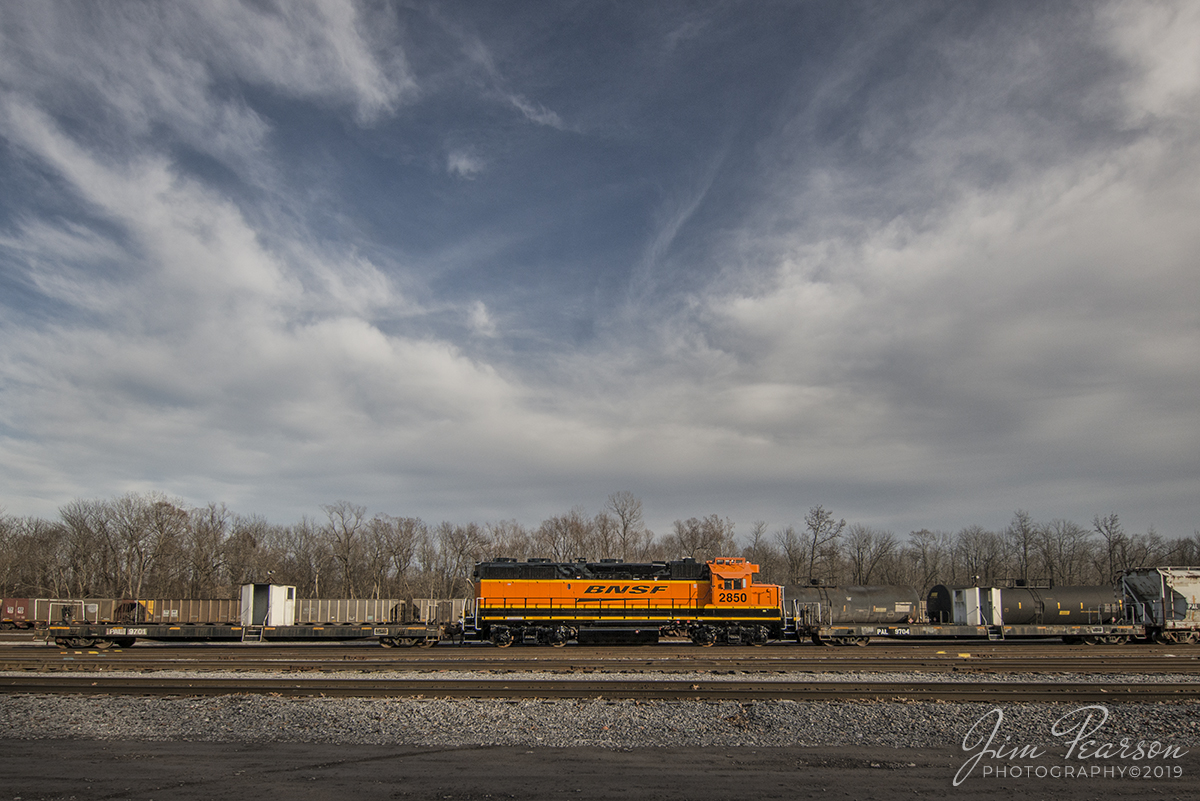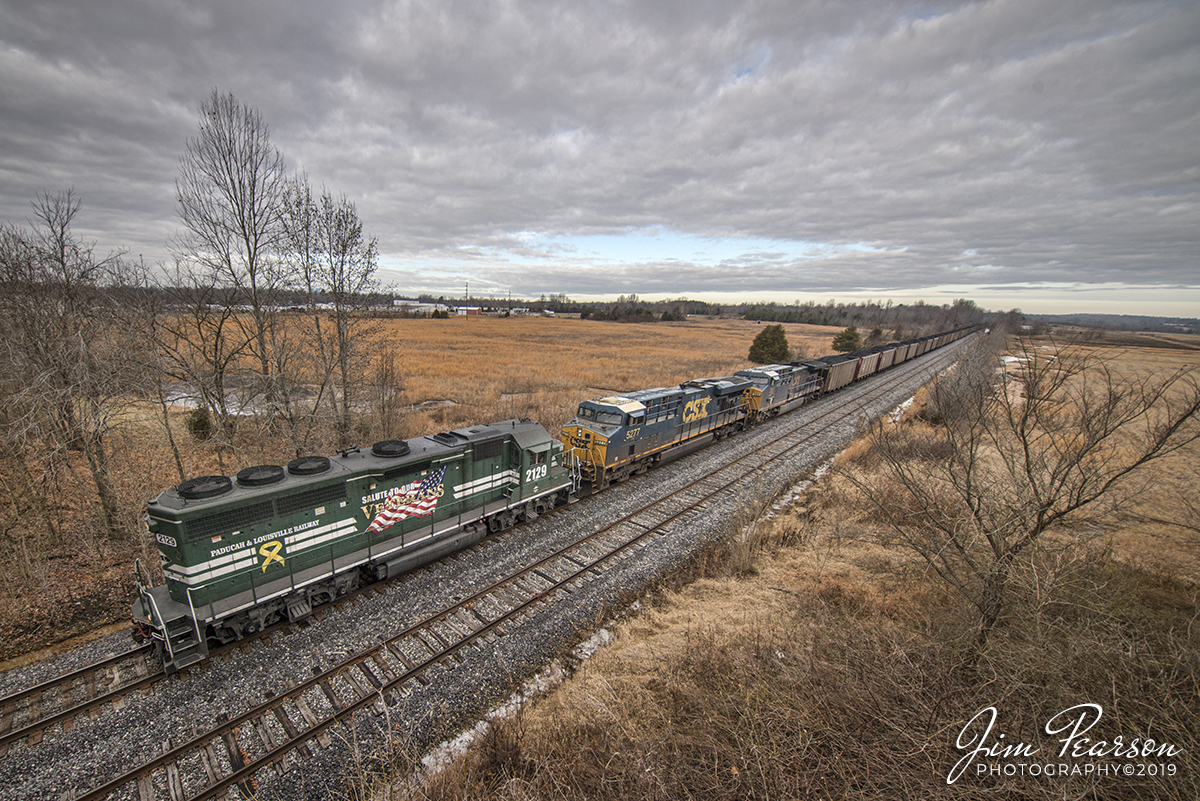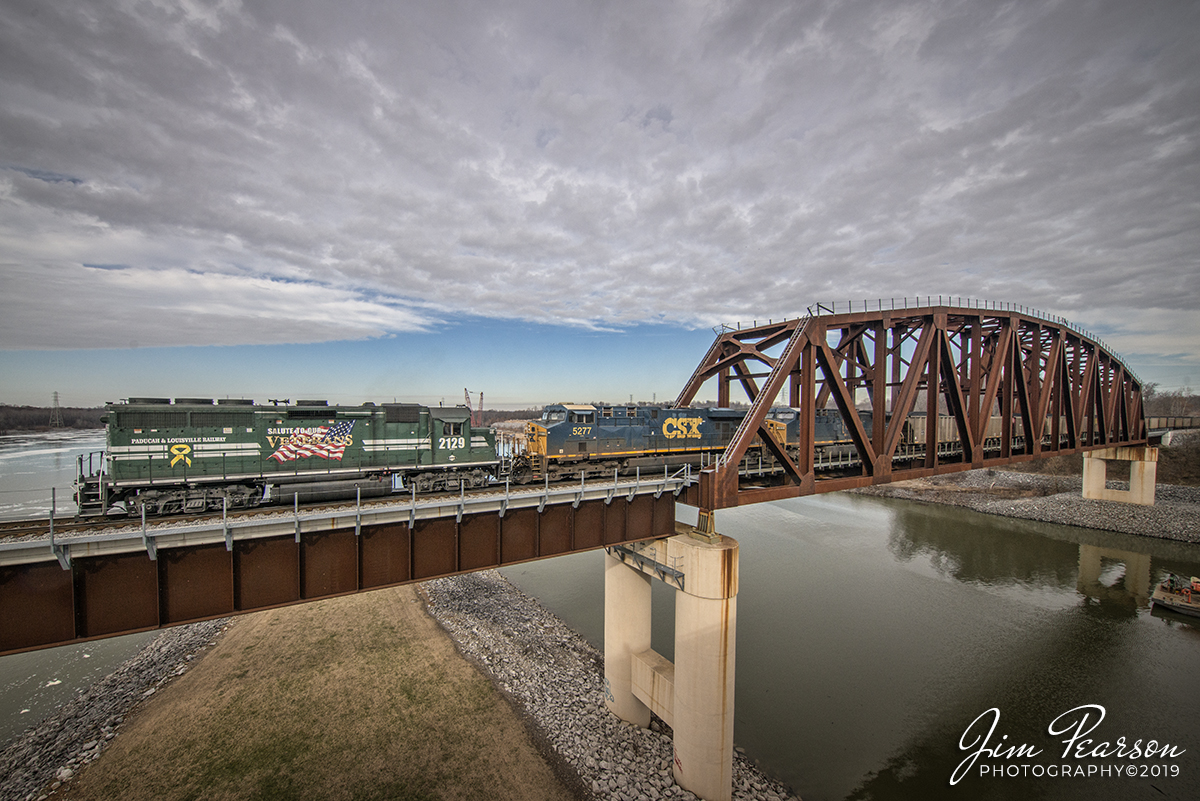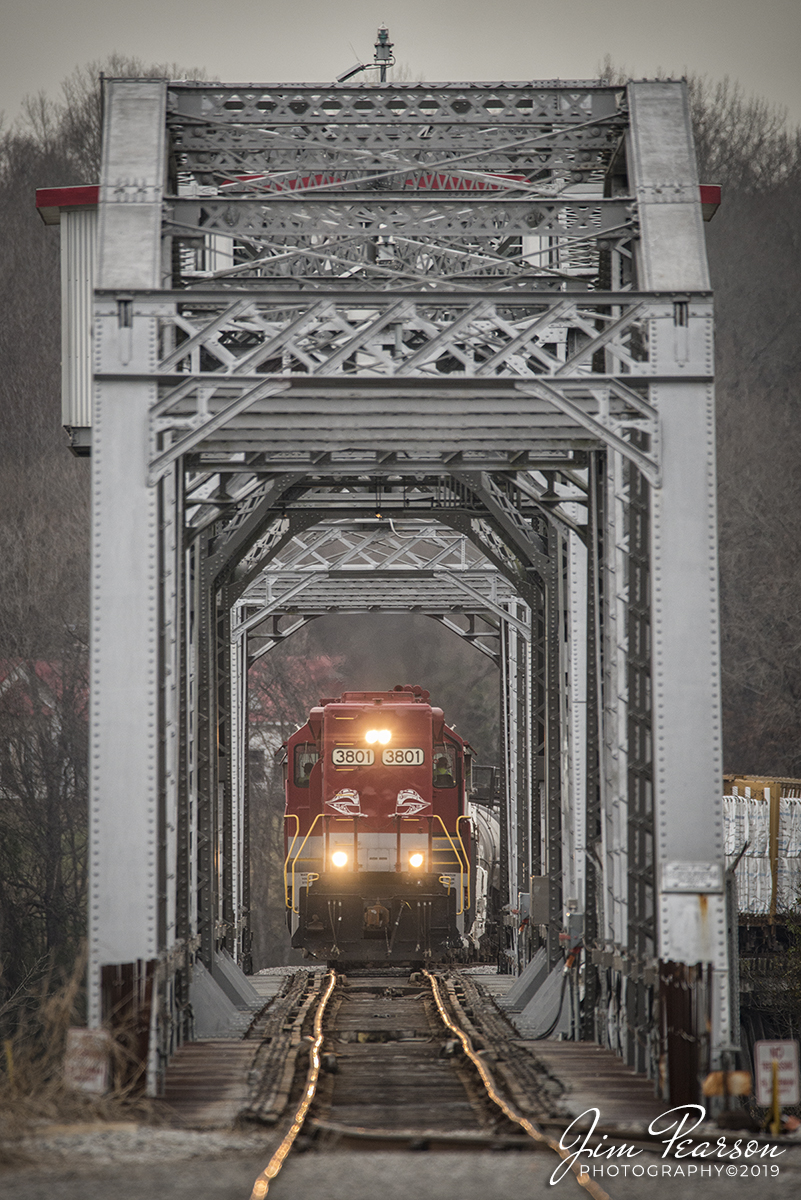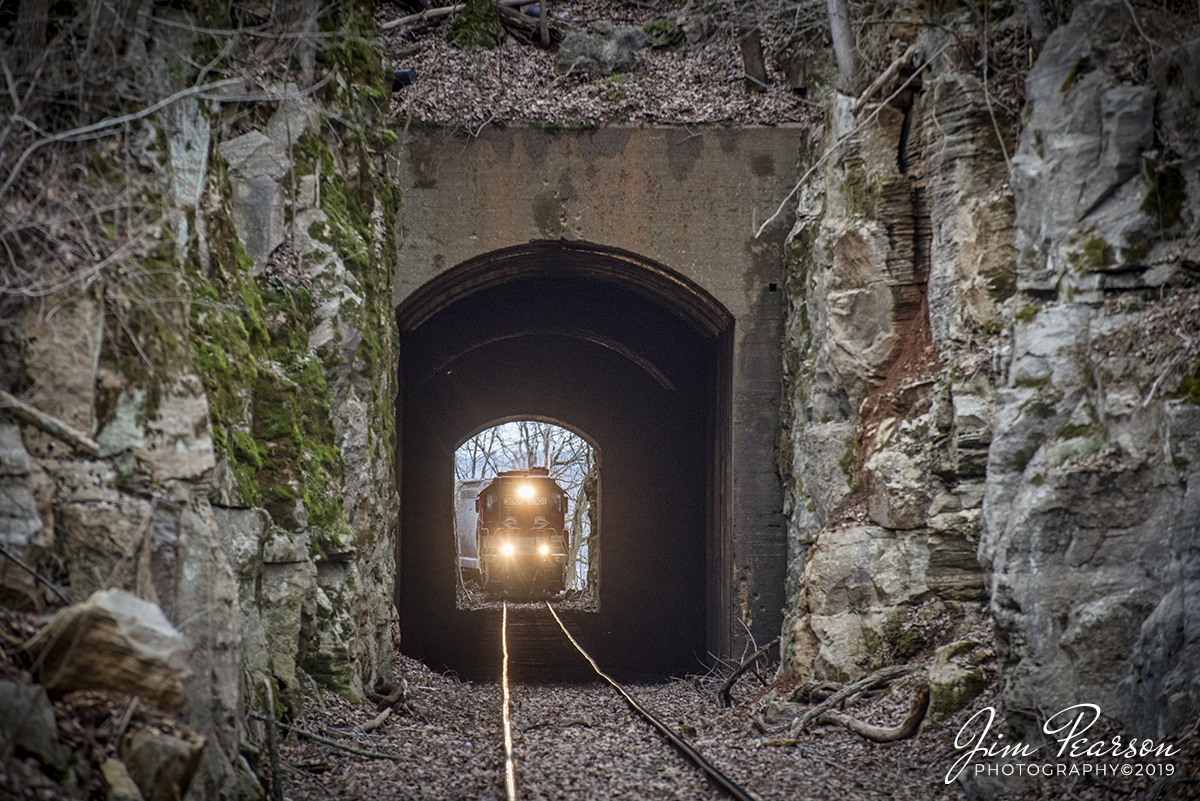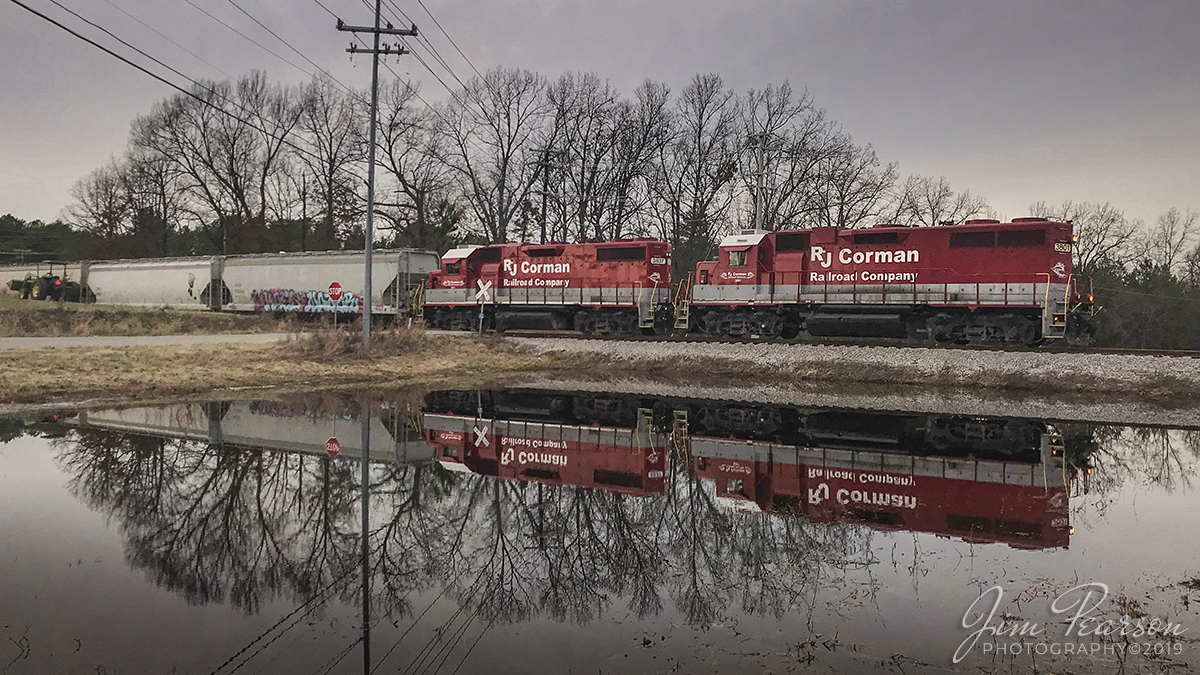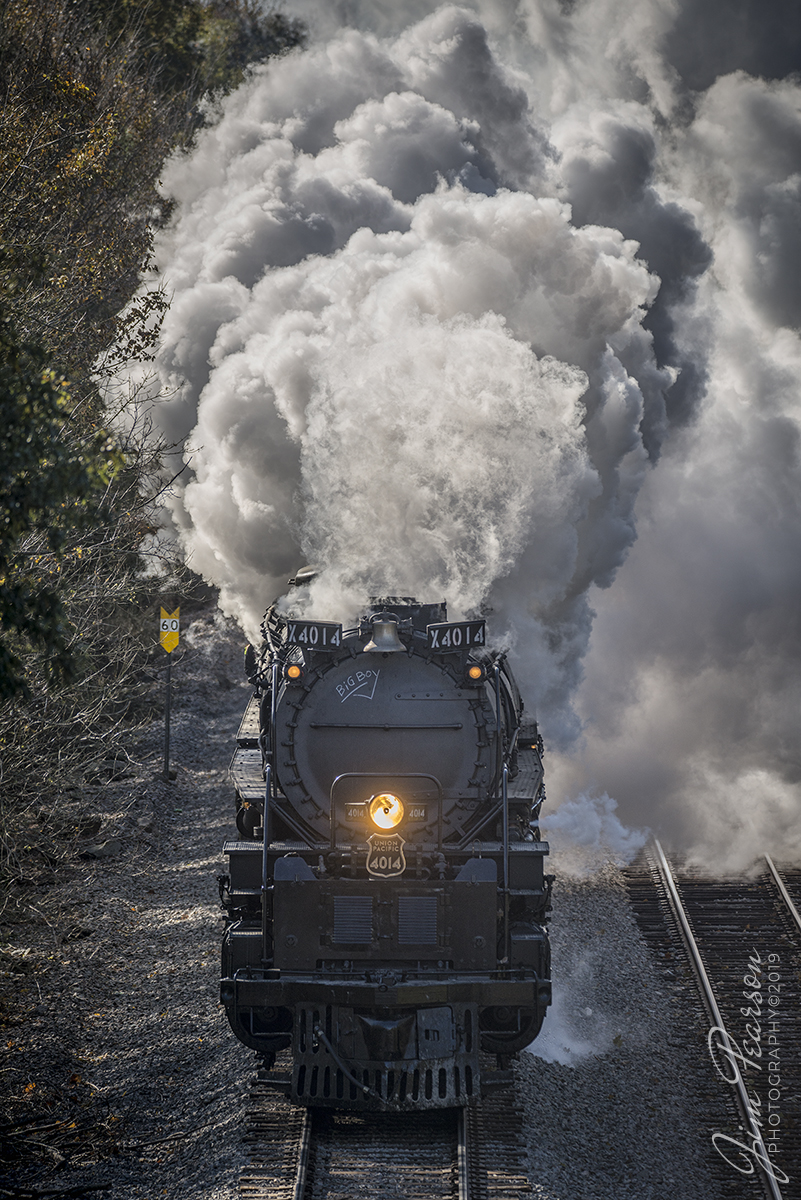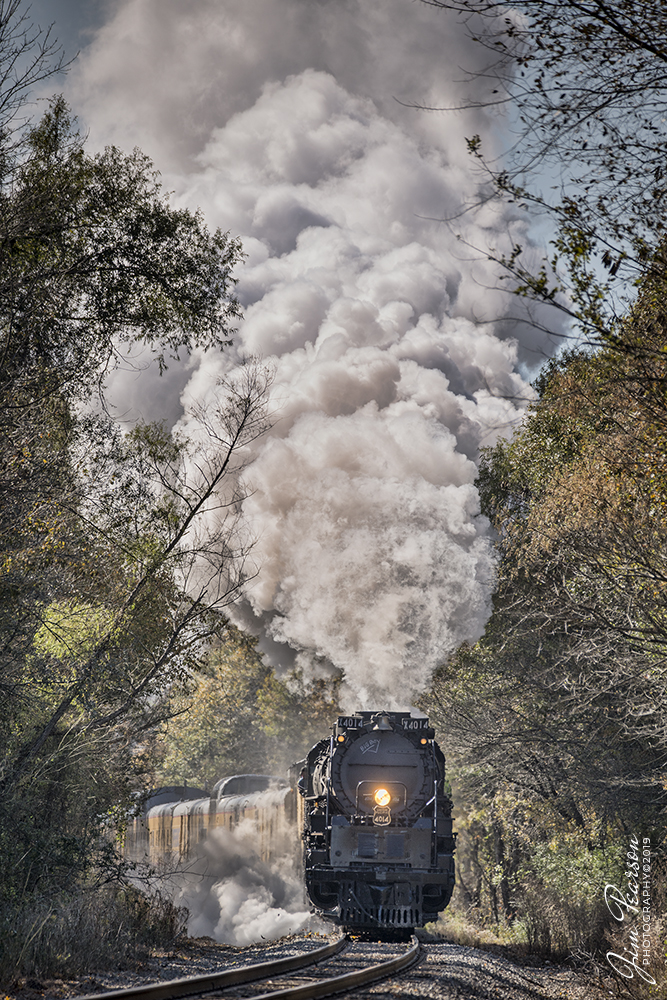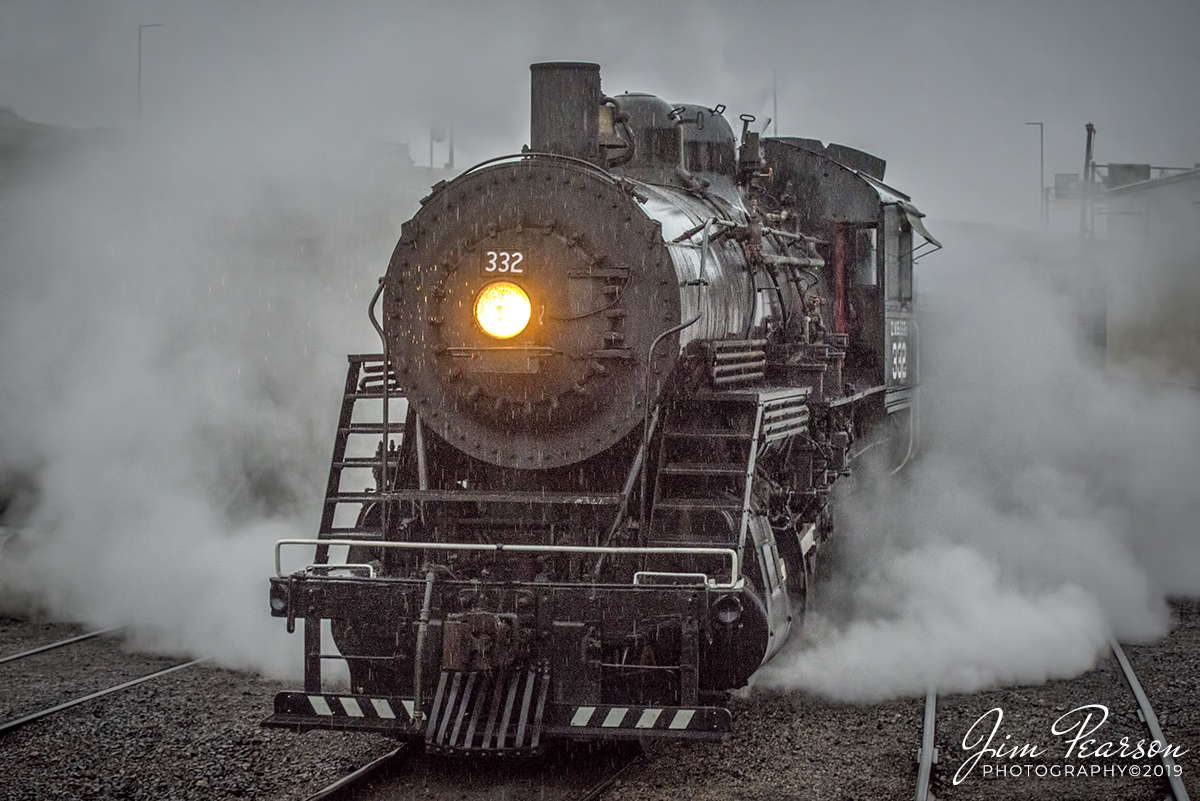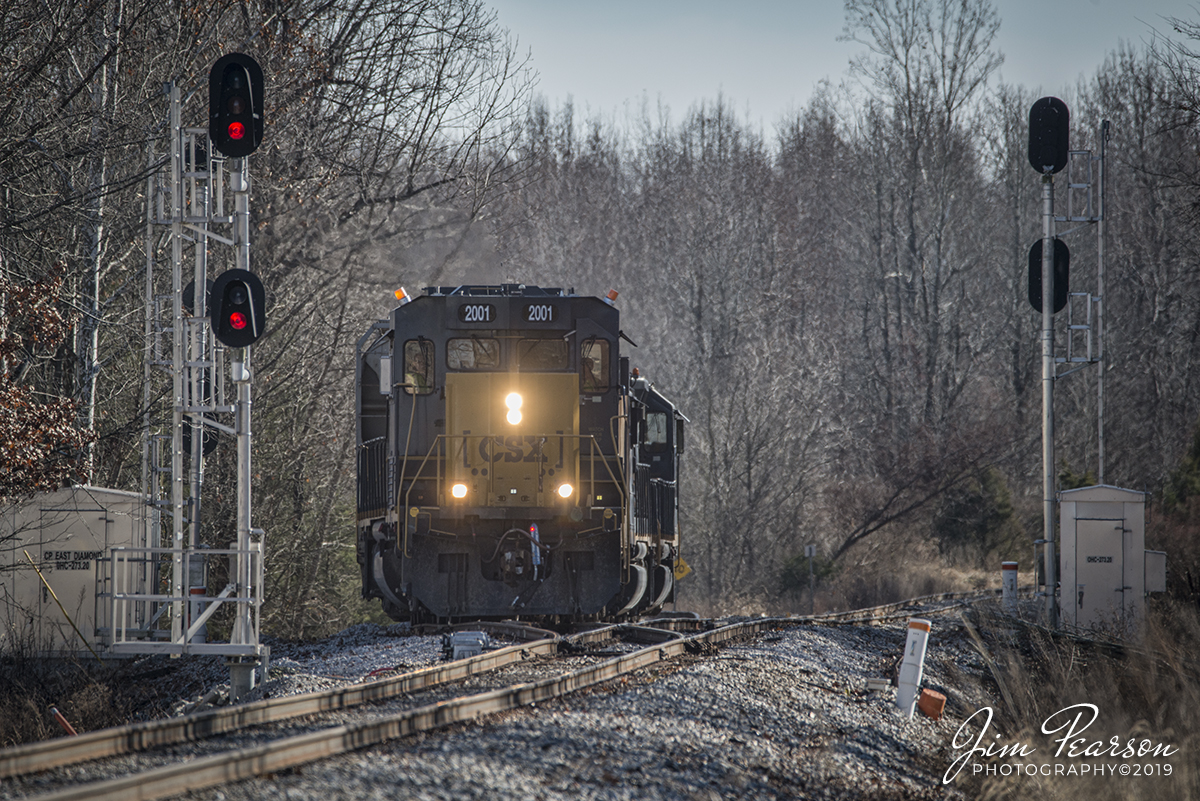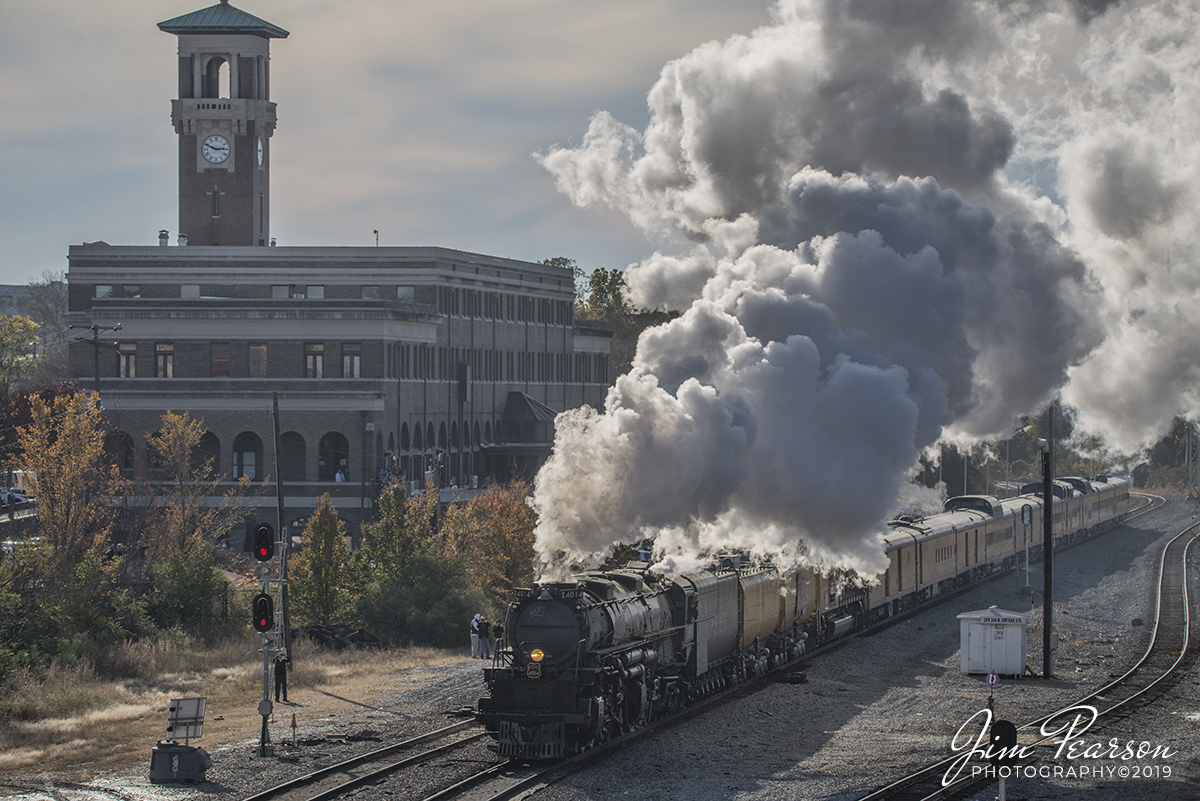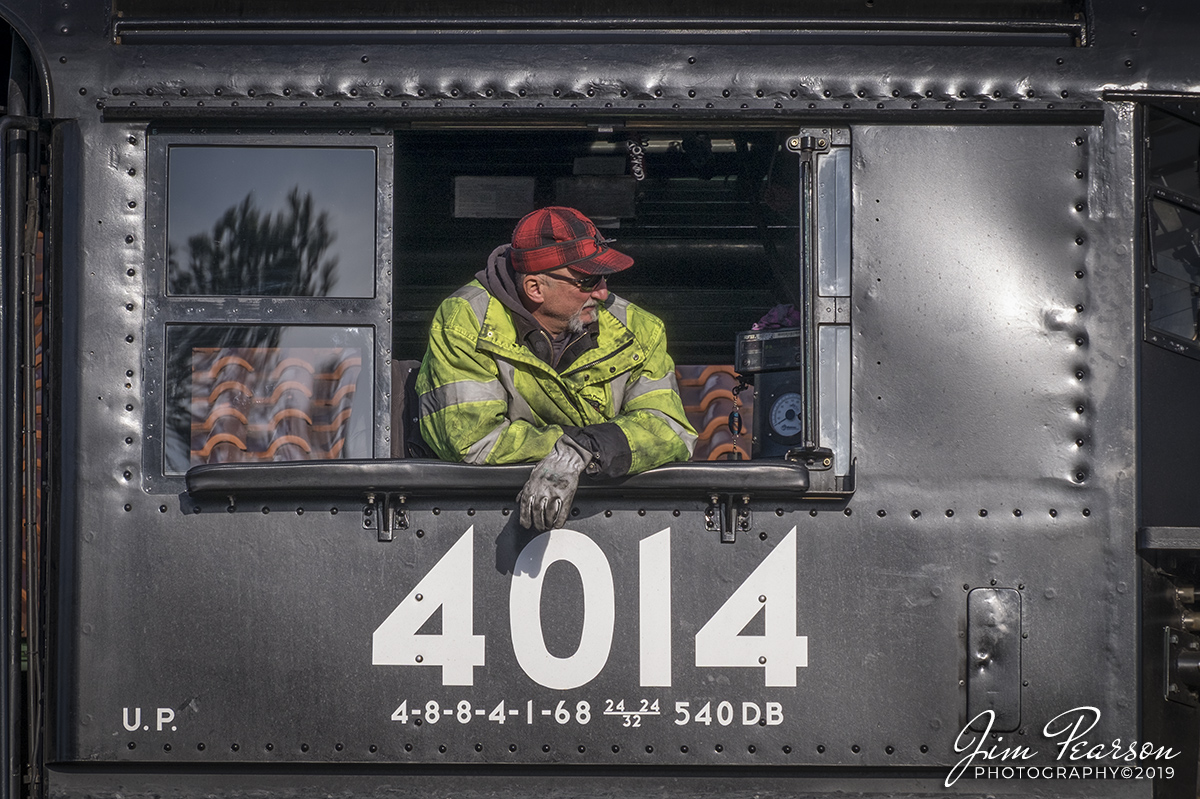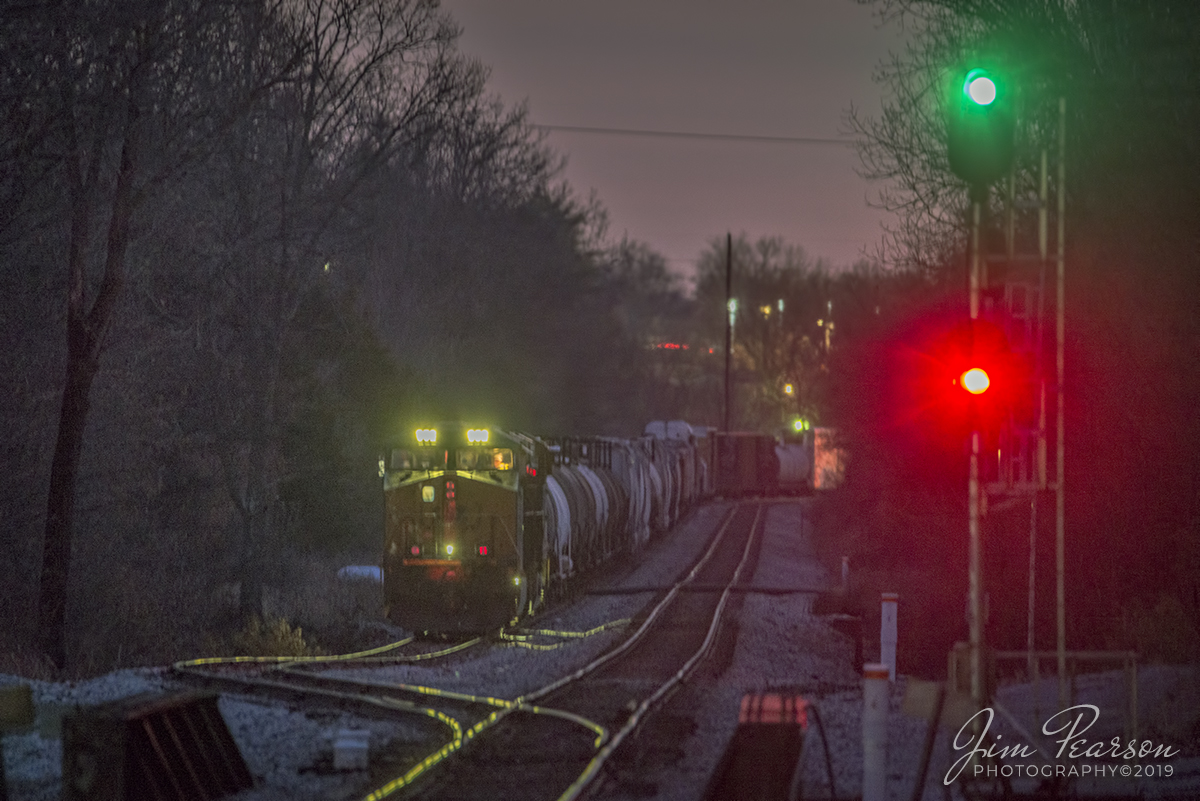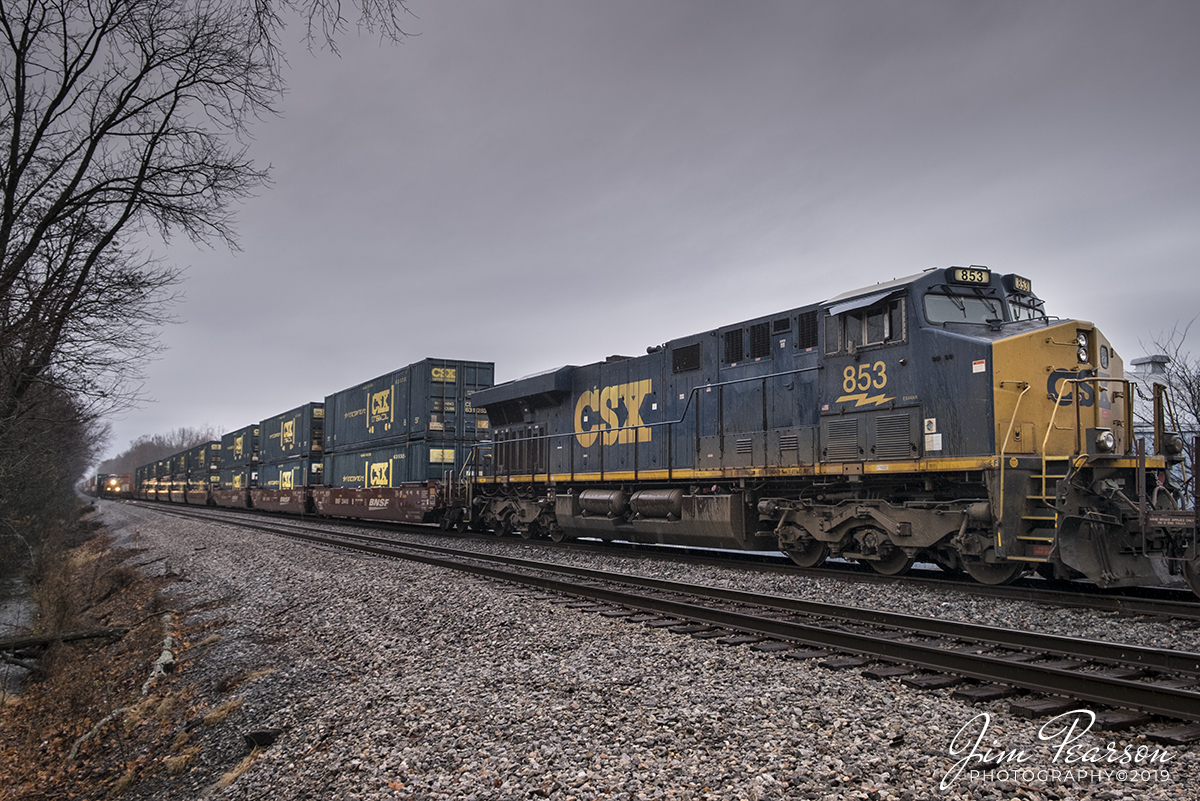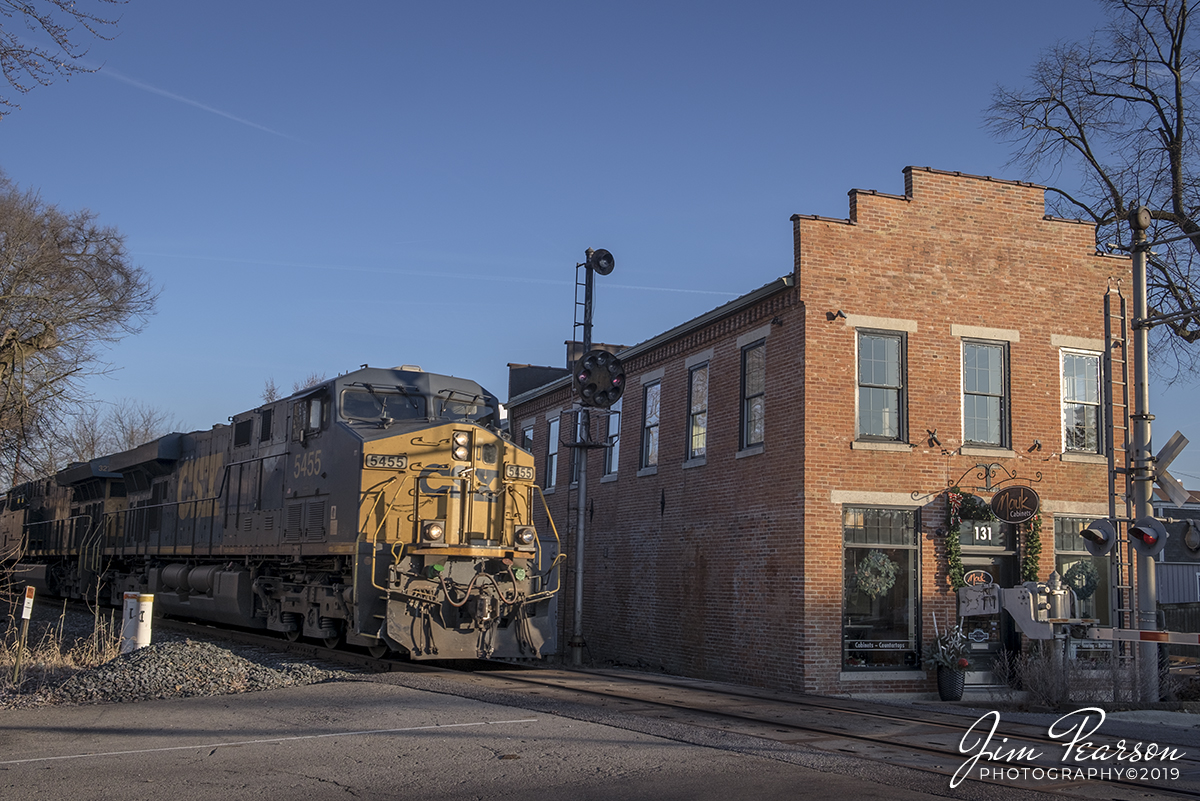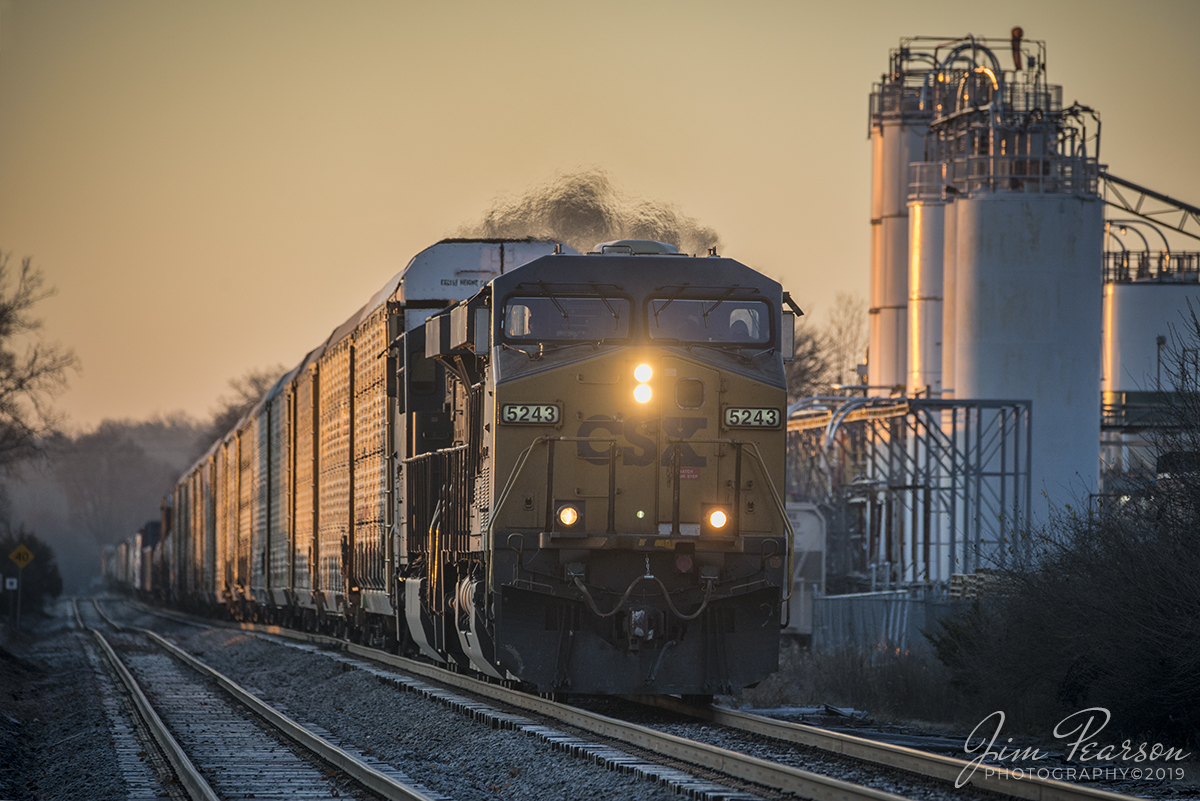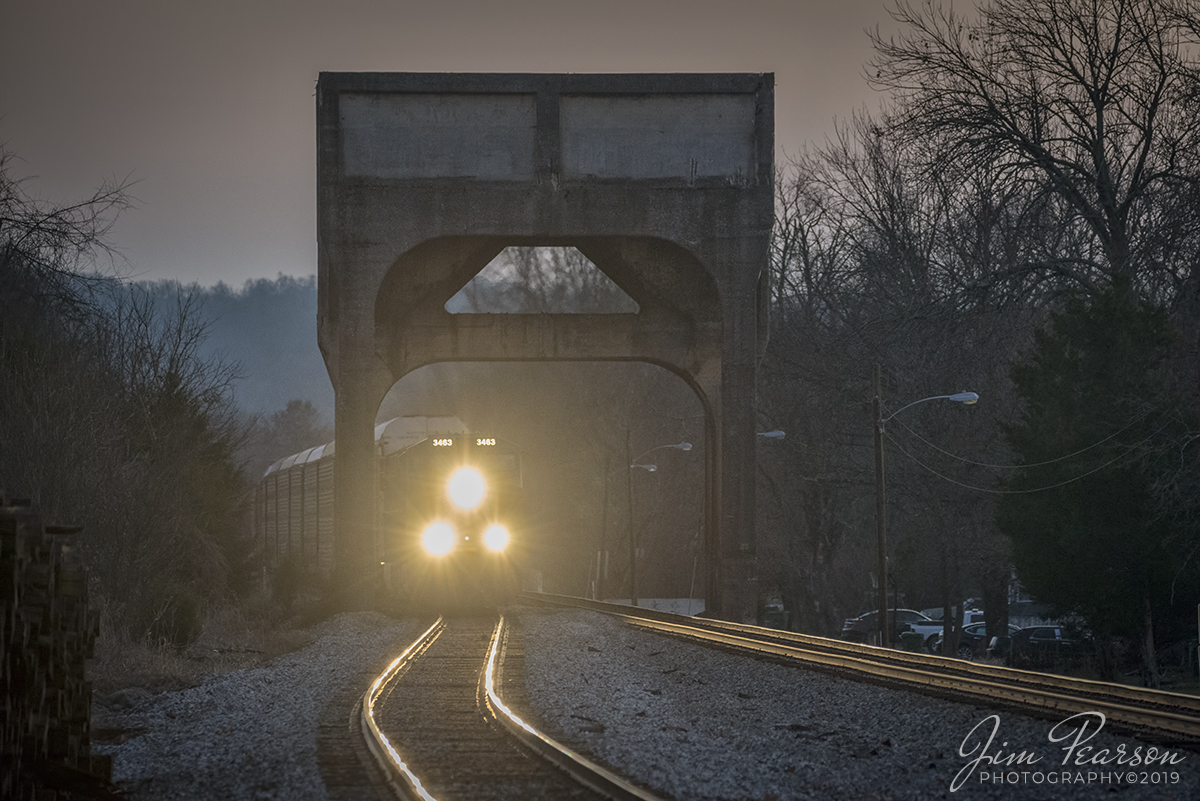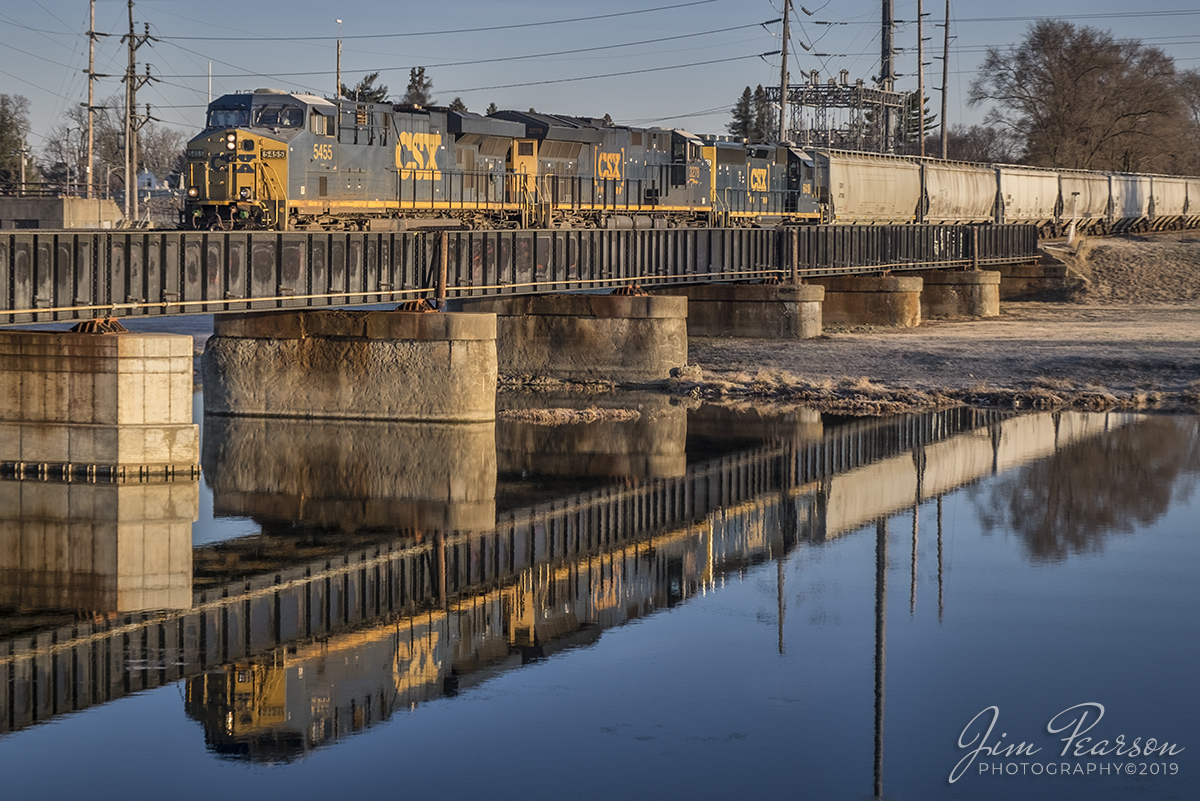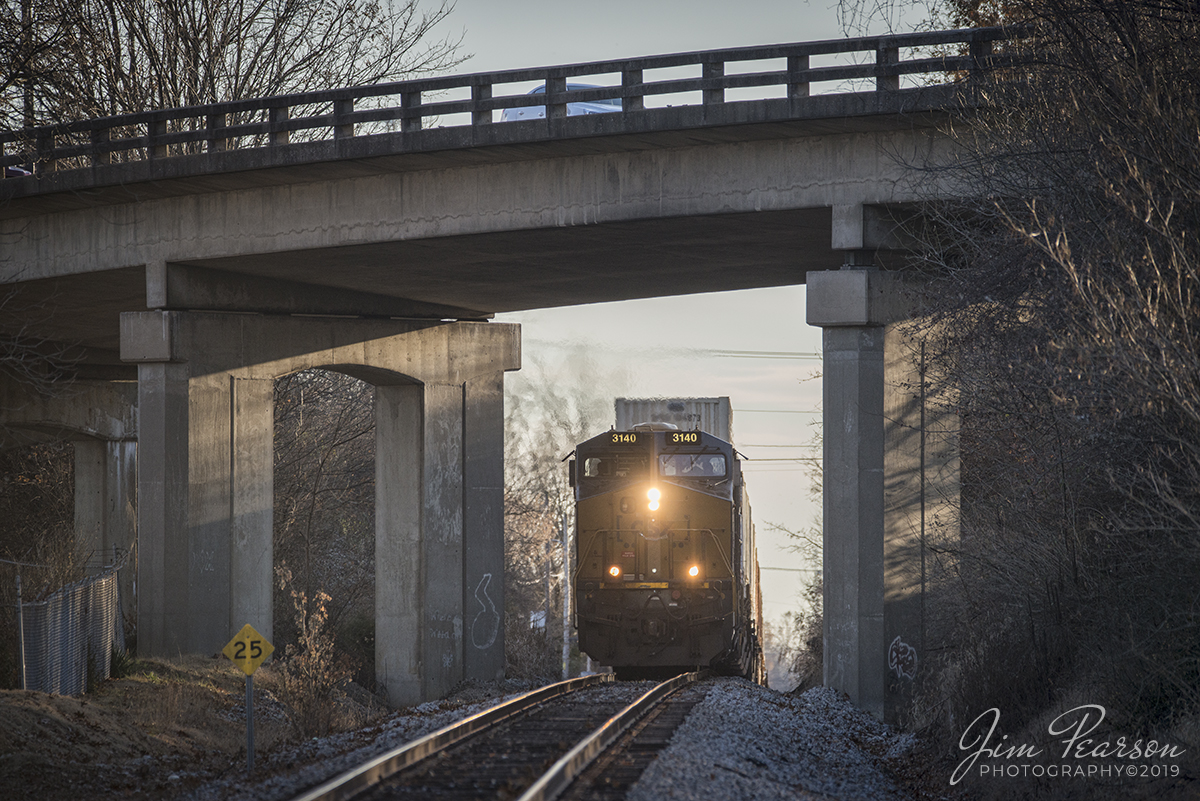December 27, 2019 – This 600mm lens shot is of Fredonia Valley Railroad (Owned by Respondek Railroad)1605 (Ex-CP Unit) as it makes it’s way through a tunnel of trees, approaching the road crossing at Red Bud Trail outside Princeton, Kentucky running at about 5 mph, after dropping off a string of empties to the Fredonia Quarry. It was returning to Paducah and Louisville Railways’ yard at Princeton, Ky.
This small shortline runs typically M-F with on average 1 train each way daily from what I’m told. The tracks were originally owned by Illinois Central, then West Kentucky Railway and in currently operated by Respondek Railroad who serves Martin Marietta. The Railroad runs from Princeton to Fredonia, Ky for about 12 miles. There’s no access to the quarry for photos, but plenty of spots along the highway the follows the tracks most of the way.
RJ Corman 3837 & 3801 southbound at Palmyra, Tennessee
December 20, 2019 – RJ Corman 3837 & 3801 (Cumberland City Turn) meander along the Cumberland River at Palmyra, Tennessee as they head south to Cumberland City on the Memphis Line with the daily local.
A newly rebuilt/repainted BNSF 2850 GP-39 at Paducah, Ky
December 21, 2019 – A newly rebuilt/repainted BNSF 2850 GP-39 sits between two shoving platforms in the north end of the yard at Paducah & Louisville Railway in Paducah, Kentucky.
Paducah and Louisville Railway Salute to Our Veterans at Dawson Springs, Ky
December 21, 2019 – Paducah and Louisville Railway’s Salute to Our Veterans GP40-2 runs long nose forward as it along the siding at Dawson Springs, Kentucky pulling a CSX loaded coal train. They were headed south to Calvert City Terminal.
Paducah and Louisville Railway’s Salute to Our Veterans unit at Gilbertsville, Ky
December 21, 2019 – Paducah and Louisville Railway’s Salute to Our Veterans GP40-2 runs long nose forward as it crosses the bridge at Kentucky Dam at Gilbertsville, Kentucky pulling a CSX loaded coal train over the Tennessee river. They were headed south to Calvert City Terminal with their loaded train when they passed my house in Richland, Kentucky and it was very unusual to see the lash-up this way so I had to give chase!! A nice early Christmas present for me!!
RJ Corman’s Cumberland City turn at the Cumberland River, Clarksville, TN
December 20, 2019 – RJ Corman’s Cumberland City turn local prepares to cross the bridge over the Cumberland River as it makes it’s return trip northbound on the Memphis Line at Clarksville, Tennessee with RJC 3801 and 3837 leading with their long noses forward elephant style for their return trip to Guthrie, Ky.
It is a Swing through truss bridge and was constructed in 1891 by the Pencoyd Bridge & Construction Company for the Nashville, Chattanooga, and St. Louis Railway. It is still an operating bridge on the river and sees at most two trains a day, but most days only one. Trains head to Cumberland City, TN (SB) usually around 9:30am CST and return north on average about 2:30-3:30pm CST.
RJ Corman’s Cumberland City turn at Railroad Tunnel
December 20, 2019 – RJ Corman’s Cumberland City turn local prepares to enter Palmyra Railroad Tunnel as it makes it’s return trip northbound on the Memphis Line at Palmyra, Tennessee with RJC 3801 and 3837 leading with their long noses forward elephant style for their return trip to Guthrie, Ky.
Palmyra is a very small town southwest of Clarksville, TN and from what I can find the tunnel is about 800-1000 ft. long.
The Memphis line follows the Cumberland River between Clarksville and Cumberland City and here at Palmyra, there is a large bluff overlooking the river which required a tunnel to be blasted through it.
The line was originally built by the Memphis, Clarksville & Louisville Railroad (MC& L) which eventually became part of L&N.
RJ Corman Cumberland City Turn at Clarksville, TN
December 20, 2019 – The RJ Corman Cumberland City Turn is reflected in a small pond as it crosses over Dunlop Road as it continues its move north on the Memphis Line after making a pickup at Letica Plastics in Clarksville, Tennessee. A big shout out to fellow railfan Cooper Smith for showing me this line today between Guthrie, Ky and Cumberland City, TN!
Union Pacific’s “Big Boy” 4014 puts out a huge plume of steam in the cold November air as it departs Hope, AR
November 12, 2019 – Union Pacific’s “Big Boy” 4014 puts out a huge plume of steam in the cold November air as it departs Hope, Arkansas and heads north on Union Pacific’s Little Rock Subdivision on its way to Prescott, AR where it tied down for the night.
According to Wikipedia: The Union Pacific Big Boy is a type of simple articulated 4-8-8-4 steam locomotive manufactured by the American Locomotive Company between 1941 and 1944 and operated by the Union Pacific Railroad in revenue service until 1959.
The 25 Big Boy locomotives were built to haul freight over the Wasatch mountains between Ogden, Utah, and Green River, Wyoming. In the late 1940s, they were reassigned to Cheyenne, Wyoming, where they hauled freight over Sherman Hill to Laramie, Wyoming. They were the only locomotives to use a 4-8-8-4 wheel arrangement: four-wheel leading truck for stability entering curves, two sets of eight driving wheels and a four-wheel trailing truck to support the large firebox.
Eight Big Boys survive, most on static display at museums across the country. This one, No. 4014, was re-acquired by Union Pacific and restored to operating condition in 2019, regaining the title as the largest and most powerful operating steam locomotive in the world.
Union Pacific’s “Big Boy” 4014 at Hope, AR
November 12, 2019 – Union Pacific’s “Big Boy” 4014 puts out a huge plume of steam as it rounds a curve in the cold November air at Hope, Arkansas as it heads north on the UP’s Little Rock Subdivision on its way to Prescott, AR where it tied down for the night during Union Pacific’s Great Race Across the Southwest tour.
Duluth, Missabe & Iron Range 332 at Duluth, Minnesota
September 5, 2019 – The Duluth, Missabe & Iron Range 332 steam locomotive, at Lake Superior Railroad Museum, prepares for a day long photo charter from Duluth, Minnesota to Two Harbors, Minnesota along the North Shore Line, in the early morning rain.
CSX local J732-27 comes off the East Diamond Lead at Madisonville, Ky
November 27, 2019 – After making a drop-off and pickup at Reed Minerals in Drakesboro, KY via the Paducah and Louisville Railway line to Central City, CSX local J732-27 comes off the East Diamond Lead as it returns to Madisonville, Ky and the Henderson Subdivision with its short train of two cars and 3 units.
Union Pacific 4014 Big Boy pulls it’s train north out of Union Station at Little Rock, Arkansas
November 13, 2019 – Union Pacific 4014 Big Boy pulls it’s train north out of Union Station at Little Rock, Arkansas on a cold fall afternoon.
Union Pacific billed this move as The Great Race Across the Southwest as the train is making a circle around the southwest over a six week or so period hitting Arkansas, Arizona, California, Colorado, Kansas, Missouri, Nevada, New Mexico, Oklahoma, Texas, Utah and Wyoming.
According to Wikipedia: Little Rock Union Station, also known as Mopac Station, is a train station in Little Rock, Arkansas, United States served by Amtrak, the national railroad passenger system.
The present Little Rock station opened August 1, 1921, having been constructed by the Missouri Pacific Railroad after a fire destroyed the prior station on April 7, 1920. The structure used existing foundations, some exterior walls and the clock tower of the previous station, which had survived the fire. The station is listed on the National Register of Historic Places as “Mopac Station”.
Although known as Union Station, this particular structure was used by only a single railroad, Missouri Pacific. Prior structures on this site were served by two additional railroads, Memphis & Little Rock (1874–1893) and St. Louis Southwestern Railroad (known as the ‘Cotton Belt’). (ca. 1892–1910). The present (1921) structure was predated by a large wooden structure erected in 1874, and a brick station that opened in 1909 and burned in 1920.
The main entrance to Union Station was located on the Markham Street level, and waiting rooms, ticket office and a restaurant were located on this level. The upper two floors housed the railroad’s train dispatchers and offices of the freight and passenger departments, American Refrigerator Transit, and the Pullman Company, which staffed the sleeping and dining cars of passenger trains. The basement (track level) held extensive mail and Railway Express Agency facilities, a baggage room, and a small dining car commissary. Passenger access to the tracks was via an open air midway extending from the north side of the building, with stairways and three umbrella sheds extending in each direction at track level. This midway structure was original to the 1908 station, having survived the 1920 fire.
Missouri Pacific passenger service to Little Rock ended just after midnight on May 1, 1971. The remaining umbrella sheds and midway were dismantled in October 1973, less than six months before Amtrak began a new passenger route through Little Rock. Amtrak continued to use the original waiting room and ticket office area until July 1992. The waiting area and ticket offices were relocated to a newly renovated area of the station located at track level.
Union Pacific Big Boy 4014 at Prescott, AR
November 13, 2019 – A crewmember on Union Pacific Big Boy 4014 keeps a watchful eye on ground operations as the train works to get ready to depart from Prescott, Arkansas on its way to Little Rock on UP’s Little Rock Subdivision.
CSX Q500 waits in the dark at Hopkinsville, Ky
December 12, 2019 – CSX Q500 waits in the dark at the north end of Latham Siding as it waits for its counterpart, Q501 to pass it, at Hopkinsville, Kentucky on the Henderson Subdivision.
CSX Q025 heads south at Guthrie, Ky
November 30, 2019 – CSX Q025 heads south as it prepares to meet the mid-train DPU on its counterpart, Q026 waiting in the siding to continue its trip north, on the Henderson Subdivision at Guthrie, Kentucky on a wet and rainy afternoon.
CSXT 5455 leads J783-07 at Tipp City, Ohio
December 7, 2019 – CSXT 5455 leads J783-07 past a still active B&O Signal at Tipp City, Ohio, as it heads south on the Toledo Subdivision in the early morning light.
CSX Q506-07 races the early morning sun at Troy, Ohio
December 7, 2019 – CSX Q506-07 races the early morning sun as it passes the Deltech Polymers Corporation plant at Troy, Ohio, as it heads north on the Toledo Subdivision.
According to Wikipedia: The Toledo Subdivision is a railroad line owned and operated by CSX Transportation in the U.S. state of Ohio. The line runs from Hamilton (north of Cincinnati) north to Perrysburg (near Toledo) along a former Baltimore and Ohio Railroad line.
The south end of the Toledo Subdivision is at the end of the Cincinnati Terminal Subdivision, near the east end of the Indianapolis Subdivision. Its north end is at the end of the Toledo Terminal Subdivision. In between, it junctions with the Middletown Subdivision at New Miami, the Indianapolis Line Subdivision at Sidney, and the Garrett Subdivision at Deshler.
South of Dayton, the Toledo Subdivision was opened by the Cincinnati, Hamilton and Dayton Railroad in 1851. Later that decade in 1858, the Dayton and Michigan Railroad opened, continuing the line to Toledo. The lines passed to the Baltimore and Ohio Railroad and CSX through leases and mergers.
CSXT 3463 leads CSX Q224 under the old coaling tower at Lebanon Junction, Kentucky
December 7, 2019 – As the last light of the day fades, CSXT 3463 leads CSX Q224 under the old coaling tower at Lebanon Junction, Kentucky as it heads north on the Mainline Subdivision (Short Line).
According to Wikipedia: Lebanon Junction sprang into existence from a railroad switching point that split Louisville and Nashville Railroad (now CSX Transportation) traffic off the mainline to the Lebanon branch that ended in Lebanon, Kentucky. This branch was completed no later than March 8, 1858, and the town grew out of a need for railroad workers to man the terminal and switching station.
A coaling tower, coal stage or coaling station is a facility used to load coal as fuel into railway steam locomotives. Coaling towers were often sited at motive power depots or locomotive maintenance shops.
Coaling towers were constructed of wood, steel-reinforced concrete, or steel. In almost all cases coaling stations used a gravity fed method, with one or more large storage bunkers for the coal elevated on columns above the railway tracks, from which the coal could be released to slide down a chute into the waiting locomotive’s coal storage area. The method of lifting the bulk coal into the storage bin varied. The coal usually was dropped from a hopper car into a pit below tracks adjacent to the tower. From the pit a conveyor-type system used a chain of motor-driven buckets to raise the coal to the top of the tower where it would be dumped into the storage bin; a skip-hoist system lifted a single large bin for the same purpose. Some facilities lifted entire railway coal trucks or wagons. Sanding pipes were often mounted on coaling towers to allow simultaneous replenishment of a locomotive’s sand box.
As railroads transitioned from the use of steam locomotives to the use of diesel locomotives in the 1950s the need for coaling towers ended. Many reinforced concrete towers remain in place if they do not interfere with operations due to the high cost of demolition incurred with these massive structures.
CSXT 5455 leads J783-07 across the Great Miami River at Troy, Ohio
December 7, 2019 – CSXT 5455 leads J783-07 across the Great Miami River at Troy, Ohio as it heads south on the Toledo Subdivision.
According to Wikipedia: The Toledo Subdivision is a railroad line owned and operated by CSX Transportation in the U.S. state of Ohio. The line runs from Hamilton (north of Cincinnati) north to Perrysburg (near Toledo) along a former Baltimore and Ohio Railroad line.
The south end of the Toledo Subdivision is at the end of the Cincinnati Terminal Subdivision, near the east end of the Indianapolis Subdivision. Its north end is at the end of the Toledo Terminal Subdivision. In between, it junctions with the Middletown Subdivision at New Miami, the Indianapolis Line Subdivision at Sidney, and the Garrett Subdivision at Deshler.
South of Dayton, the Toledo Subdivision was opened by the Cincinnati, Hamilton and Dayton Railroad in 1851. Later that decade in 1858, the Dayton and Michigan Railroad opened, continuing the line to Toledo. The lines passed to the Baltimore and Ohio Railroad and CSX through leases and mergers.
CSXT 3140 leads intermodal Q026 at Madisonville, Ky
November 27, 2019 – CSXT 3140 leads intermodal Q026 as it crests the rise under the North Main Street overpass at Madisonville, Kentucky as it heads north on the Henderson Subdivision.

